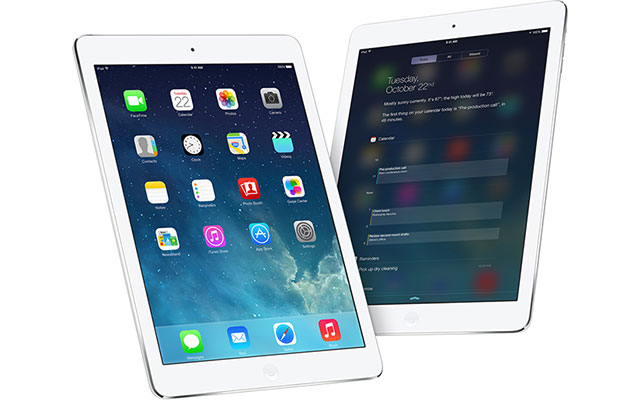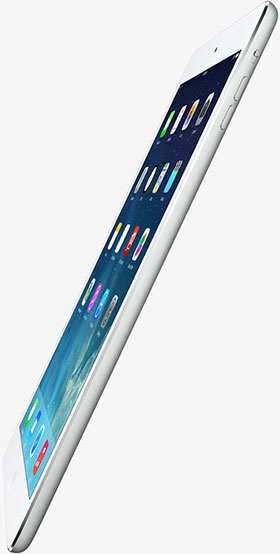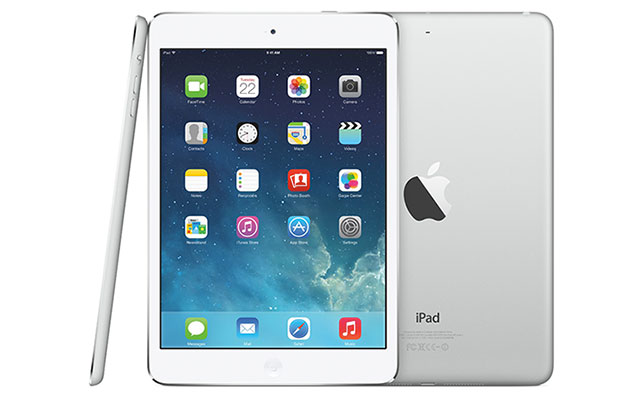
The iPad Air is Apple’s fifth-generation tablet, released three-and-a-half years after the original groundbreaking device. At the announcement of the iPad Air in October, Apple CEO Tim Cook said the company sold more than 170m iPads to date, so there’s no denying it’s the preferred tablet choice for many.
The new one, as everyone knows by now, is thinner and lighter and faster. But is it enough to justify the upgrade?
The biggest change on the new model is its redesign — it’s the first major overhaul of the iPad’s design. It looks exactly like a bigger iPad Mini, with the same slim design and flat back. Compared to its predecessor, the iPad 4, the bezel is 43% narrower and the tablet is 20,2% thinner. The same 9,7-inch “Retina” display is crammed into its 169,5mm x 7,5mm x 240mm dimensions, compared to the fourth-gen iPad’s 185,7mm x 9,4mm x 241,2mm.
The 2 048 x 1 536-pixel display, with its 264ppi pixel density, remains the same and is still the best tablet display we’ve used. Whether you are browsing the Web, watching high-definition videos or playing games, text appears crisp and images and video look amazing.
The Air weighs just 469g, shaving an incredible 183g off its predecessor. The lighter device is now easier to hold with one hand without needing to shift its weight over every now and then.
The tablet comes in two colours — white/silver and the same grey/black introduced with the iPhone 5s. The review unit we used was grey and black and we much prefer the larger device in the darker colour, especially since the matte back is less likely to show marks than the silver.
 The iPad Air carries the same minimalist front design as its predecessors, with a single home button. To the right are individual volume up and down keys, with a mute/rotation lock button above them and a micro Sim slot all the way down the bottom. On the top right is the power button, and to the left the 3,5mm audio jack. At the base are the Lightning dock and built-in speakers.
The iPad Air carries the same minimalist front design as its predecessors, with a single home button. To the right are individual volume up and down keys, with a mute/rotation lock button above them and a micro Sim slot all the way down the bottom. On the top right is the power button, and to the left the 3,5mm audio jack. At the base are the Lightning dock and built-in speakers.
The iPad Air has a faster processor — Apple claims the 64-bit A7 chip is twice as fast as its predecessor — and the same one found on the iPhone 5s. There’s also an M7 motion coprocessor. The coprocessor is used to track your movements with health- and fitness-related apps by pulling data from the accelerometer, gyroscope and compass. It draws very little power even though it’s always running in the background. (By the way, we don’t recommend that you go running with your iPad Air unless you intentionally want to look like a dork.)
From browsing and loading Web pages to playing games and switching between apps and just taking photos, the iPad Air is super fast and responsive.
When you fire up the camera, you can take pics instantly by pressing the shutter button without the tablet stuttering. When playing games using the gyroscope, the Air worked smoothly with zero lag. We also compared browsing on Safari with a previous generation iPad and the Air loaded twice as fast. We used the tablet for days without quitting any apps that were running in the background because it didn’t affect the performance whatsoever.
Naturally, the iPad Air ships with Apple’s latest mobile operating system, iOS 7. The software was rolled out in September, offering a complete overhaul in design and functionality. iOS 7 was primarily designed for the iPhone and it doesn’t really make a huge difference on the iPad.
Apart from brightly coloured icons, Control Centre, which can be accessed from the lock screen, is the most noticeable change. Although a few years too late, Control Centre gives users one-touch access from any screen to shortcuts such as Wi-Fi, Bluetooth, aeroplane mode, do-not-disturb mode, media controls and screen brightness. It also introduces a new feature from Mac OS X called AirDrop. AirDrop only works between other iOS 7 devices on the same Wi-Fi network and is not interoperable with Mac OS X. It lets users share files with each other immediately, once the right permissions have been granted.
When it comes to apps, users are spoilt for choice thanks to the extensive ecosystem. The App Store now has more than 450 000 iPad-only apps, a distinct advantage over other tablets.
Apple also announced in September that its iWork (Pages, Numbers and Keynote) and iLife (GarageBand, iPhoto and iMovie) suite of apps will be available at no cost. There are apps and games available that take advantage of the gyroscope, accelerometer and motion coprocessor. The South African iTunes Store also has a (very limited) selection of movies to buy or to rent, along with music. TV series are still not available.
Camera and battery
The iPad Air has the same 5-megapixel rear camera found on the fourth-gen iPad, with an improved front-facing 1,2-megapixel shooter. The main camera is snappy and lets you take standard and square-shaped photos and record video. It has a five-element lens with autofocus and face detection, and takes high dynamic range pictures.
Video mode records in full 1080p HD with video stabilisation, tap-to-focus and 3x video zoom. The front-facing camera, which is decent for video calling, performs better than older iPads in low-light conditions and records video in 720p HD, and has face detection.
The new dual microphone offers noise cancellation on all audio and video recordings.

The capacity of the battery on the iPad Air has been reduced to 8 820mAh, compared to the 11 560mAh found on both the third- and fourth-generation iPads. This is due to the iPad Air being physically smaller than the previous generation iPads. However, it still has an excellent battery life, promising more than 10 hours of use. In practice, we found the battery lasted just as long as the older iPads.
In summary, then, the iPad Air really is the all-round package you’d expect from a tablet. It offers the best screen in the market, has fantastic battery life and offers the widest selection of apps on any platform.
But it’s going to be a tough choice deciding between the iPad Air and iPad mini with Retina display, which was launched this week in South Africa. — (c) 2013 NewsCentral Media
[table id=55 /]




